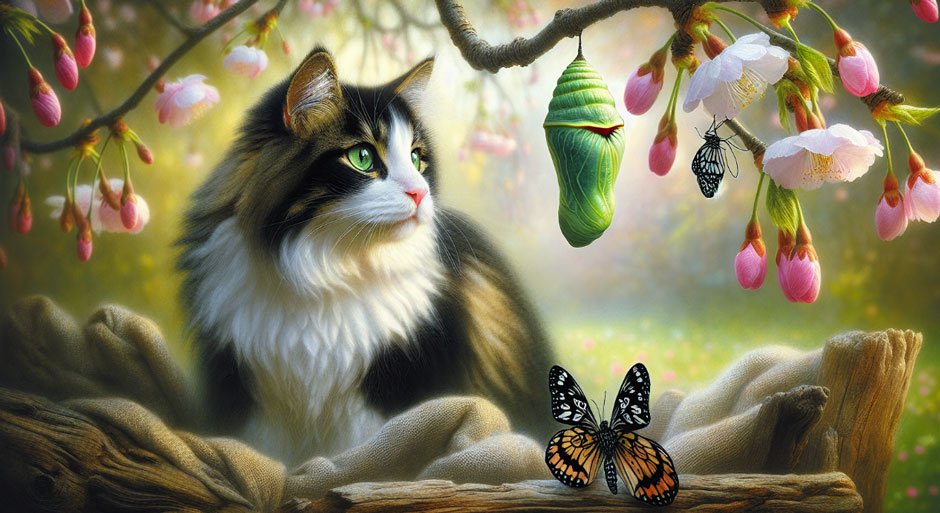“Cat in the Chrysalis” is a captivating novel that weaves together elements of mystery, growth, and transformation, engaging readers with its intricate plot and deep character arcs. Through the journey of Amelia Hart, a brilliant scientist who discovers an ancient, mystical cat figurine, the novel explores themes of change and self-discovery, making “cat in the chrysalis spoilers” a topic of fervent discussion.
This article delves into the novel’s plot twists, character development, and the rich symbolism embedded within its pages. It also examines the impact “Cat in the Chrysalis” has had on pop culture and the unique experience it offers its readers, providing comprehensive insights into why it continues to captivate and intrigue.
Plot Overview and Key Twists
“Cat in the Chrysalis” begins with the seemingly ordinary life of a blue-collar worker, Thomas, whose life takes a dramatic turn following the discovery of a hidden magical library. This discovery sets him on a perilous journey, unveiling his true identity and purpose, and introducing him to Chrysalis, a unique cat capable of speech. The novel is cleverly divided into six chapters, each marking a significant stage in Thomas’s adventures, filled with danger, mystery, and the gradual unveiling of his past.
The narrative thrives on its unexpected plot twists that consistently challenge reader expectations. One of the most startling revelations is the true nature of Jenny’s love interest, Mark, who has been manipulating her actions from behind the scenes. Additionally, the story features a telepathic cat, Chrysalis, whose abilities are pivotal to the unfolding of the plot. These elements seamlessly blend science fiction and thriller genres, maintaining a gripping pace that keeps the readers hooked till the last page.
Throughout the book, betrayals from trusted allies and the emergence of hidden enemies add layers of intrigue, culminating in an emotional ending that not only resolves the current dilemmas but also sets the stage for a sequel. The bond between Jenny and Chrysalis, enriched by their shared trials, forms the emotional core of the conclusion, leaving readers anticipating further adventures.
Character Development and Dynamics
In “Cat in the Chrysalis,” the character arcs are intricately woven into the fabric of the narrative, each adding a unique layer to the story’s psychological depth and realism. Emily, the protagonist, is portrayed with an intense emotional landscape that evolves significantly throughout the novel. Her journey from a state of self-doubt to self-discovery and eventual self-realization is marked by a series of challenges that reflect typical adolescent struggles, yet are uniquely tailored to her character.
Sarah, Emily’s steadfast confidante, plays a vital role in Emily’s transformation. Her unwavering support and understanding provide a safe space for Emily to explore her fears and ambitions. Mr. Thompson, another pivotal character, introduces Emily to the mystical concept of the chrysalis, catalyzing her transformative journey. His mysterious aura and timely interventions are crucial in guiding Emily towards her destiny.
The Chrysalis, not just a symbol but also a character, mirrors Emily’s transformation. This enigmatic cat embodies resilience and curiosity, guiding Emily through her darkest moments and towards enlightenment. The dynamic interplay between these characters enriches the narrative, making their developments resonate with readers, leaving a lasting impact beyond the final page.
Themes and Symbolism
In “Cat in the Chrysalis,” the interplay of themes and symbols enriches the narrative, weaving a tapestry that explores the complexities of human emotions and evolution. The chrysalis, a recurrent motif, stands as a powerful symbol of transformation and rebirth. It reflects the characters’ journeys from confinement to the revelation of their true selves, mirroring the metamorphosis of a butterfly. This symbolism is tightly interlinked with the theme of identity, as the characters grapple with understanding and accepting their inner selves in the face of external challenges.
The narrative delves into the philosophical, posing significant questions about the human condition, identity, and the relentless pursuit of knowledge. These themes are explored through the characters’ interactions and the choices they make, highlighting the impact of love, loss, and betrayal on personal growth. The ancient cat figurine, central to the story, acts as a catalyst for change, symbolizing the potential for profound personal evolution when one embraces their true nature.
Furthermore, the novel addresses the universal struggle of coming of age, where the characters confront the uncertainties of growing up and the complexities of their identities and perceptions. Through its intricate plot twists and the development of multi-dimensional characters, the story invites readers to reflect on their own experiences of transformation and the often-painful process of self-discovery. The chrysalis not only symbolizes growth and self-discovery but also the inevitable pain that often accompanies significant personal change, making it a resonant symbol for the readers’ transformative processes as well.
Impact on Pop Culture and Reader Experience
“Cat in the Chrysalis” has significantly influenced popular culture, sparking a broad spectrum of creative and academic pursuits. The novel’s unique narrative and memorable characters have not only inspired fan art and fan fiction but have also led to extensive academic analysis. This cultural phenomenon indicates the deep connection readers and critics alike have with the story, often leading to vibrant discussions and debates across various platforms.
The book’s impact extends to influencing contemporary writers, with its innovative themes and narrative style serving as a benchmark in literary circles. This influence is evident as it encourages new authors to explore complex character dynamics and intricate plot developments in their works. Such literary contributions enrich the literary landscape, offering fresh perspectives and challenging conventional storytelling methods.
Moreover, the novel’s ability to invite diverse interpretations adds a layer of richness to its analysis, as each reader brings their unique perspective, influenced by their personal experiences. This subjective engagement with the text not only deepens the reader’s experience but also broadens the scope of discussions surrounding the novel’s themes and characters, making “Cat in the Chrysalis” a lasting subject in cultural conversations and literary critiques.







